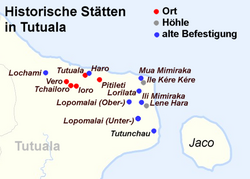Ile Kére Kére
The Ile Kére Kére cave is located near Tutuala on the eastern tip of Timor
|
Ile Kére Kére ( Ili-kere-kere ; Fataluku for "described mountains" ) is a limestone overhang at a height of about 300 m , on a steep face near Tutuala , on the eastern tip of East Timor .
Archaeological finds
Ile Kére Kére has cave paintings , the exact age of which has never been determined. Estimates assume an age of 2,000 to 6,000 years. They show hunting scenes, animistic symbols such as turtles and other animals, boats and hand prints. The shape of the boats indicates an Austronesian origin, which contradicts the Papuan origin of most of the languages in the district, but recent linguistic research suggests that Austronesians settled in the region before the Papuans. It is unclear whether the drawings represent the artists' boats or boats passing by. There are also pictures of horses that, like the other farm animals on Timor, were introduced by early immigrants.
Ile Kére Kére and the southern Lene Hara cave were investigated in the 1990s by Sue O'Connor from the Australian National University . It could prove settlements up to 30 to 35,000 years ago.
The linguist Aone van Engelenhoven reports that the resident Fataluku can not say anything about the origin of the portraits. “They have always been there.” Talking about the cave paintings is taboo among the Makuva , who may have previously settled in the region. Van Engelenhoven concluded that the speakers of Rusenu , whose now extinct language he discovered in 2007, may be the creators of the images.
Many of the symbols and images that can be found on walls in 25 locations in the area are used by the Fataluku on sacred clothes that serve as bridal gifts, as carvings in clan houses and even on Christian graves. Ile Kére Kére is considered in its mythology to be the first country where the ancestors of the Tutuala clan ( ratu ) had their first residence. It is considered the first village ( lata ). Part of Ile Kére Kére are also two holy places ( téi ) where guardian spirits live. The places are marked by wood carvings. If members of the Ratu need help or if they are ill, the “Lord of the Land” ( mua ocawa ) conducts ceremonies here.
On the northeastern Kisar there are wall paintings, some of which show striking similarities to paintings on the eastern tip of Timor. They are more than 2500 years old.
View from Ile Kére Kére to the island of Jaco
See also
literature
- Peter Bellwood : Prehistory of the Indo-Malaysian Archipelago . 2nd Revised Edition: ANU Press, Canberra 2007, ISBN 978-1-921313-12-7 .
- Ian Glover: Archeology in Eastern Timor, 1966-67. Department of Prehistory, Research School of Pacific Studies, The Australian National University, Canberra 1986, ISBN 0-86784-943-6 ( Terra Australis 11).
- Sue O'Connor: Nine New Painted Rock Art Sites from East Timor in the context of the Western Pacific Region. In: Asian Perspectives . 42, No. 1, 2003, ISSN 0066-8435 , pp. 96-128.
- Katragadda Paddayya, Peter Bellwood: South and Southeast Asia. In: Barry Cunliffe , Wendy Davies, Colin Renfrew (Eds.): Archeology. The Widening Debate. Oxford University Press for the British Academy, Oxford et al. 2002, ISBN 0-19-726255-4 , pp. 295-334.
- Matthew Spriggs, Sue O'Connor: Vestiges of Early Pre-agricultural Economy in the Landscape of East Timor. Recent Research. In: Anna Karlström, Anna Källén (Ed.): Fishbones and glittering emblems. Southeast Asian archeology 2002. Museum of Far Eastern Antiquities (Östasiatiska museet), Stockholm 2003, ISBN 91-970616-0-3 , pp. 49-58.
Web links
Individual evidence
- ^ A b Steven Hagers: Een vergeten taal op Oost-Timor . Kennislink. March 20, 2007. Retrieved March 11, 2009.
- ^ Andrew McWilliam: Austronesians in linguistic disguise: Fataluku cultural fusion in East Timor. ( Memento of November 7, 2014 in the Internet Archive ) (PDF; 171 kB)
- ^ Sue O'Connor, Matthew Spriggs, Peter Veth: Excavation at Lene Hara Cave establishes occupation in East Timor at least 30,000-35,000 years ago. ( Memento from September 23, 2015 in the Internet Archive ) In: Antiquity. March 2002, 76, 291, p. 45. (PDF; 1.2 MB)
- ^ The unofficial guide to Timor-Leste: Tutuala and the eastern tip
- ↑ John Norman Miksic, Geok Yian Goh, Sue O'Connor: Rethinking Cultural Resource Management in South East Asia: Preservation, Development, and neglect. 2011, ISBN 978-0-85728-389-4 , pp. 49ff
- ↑ Australian National University: Indonesian island found to be unusually rich in cave paintings , December 13, 2017 , accessed December 14, 2017.
Coordinates: 8 ° 23 ′ 31.5 ″ S , 127 ° 17 ′ 25.2 ″ E






